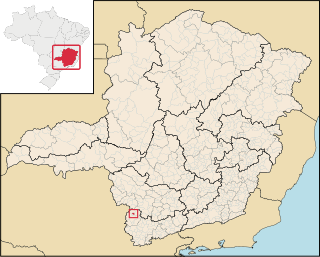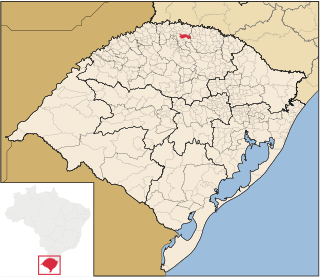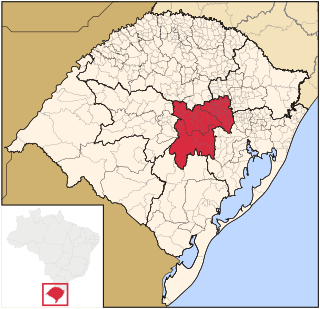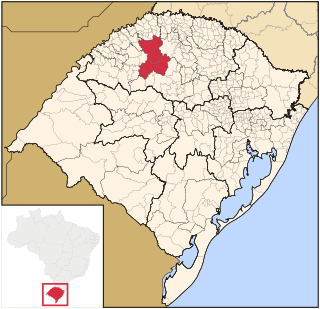
The Santiago microregion is a micro-region in the western part of the state of Rio Grande do Sul, Brazil. Its total area is of 11,213.844 km².

The Campanha Ocidental micro-region is a microregion in the western part of the state of Rio Grande do Sul, Brazil. The area is 31,125.429 km² making it the largest micro-region in the state nearly covering one-tenth of the entire state, much of the central and eastern portions remain underpopulated.

The Federal University of Pelotas is a higher-learning facility with campuses in Pelotas and Capão do Leão in Rio Grande do Sul, Brazil. The university offers more than a hundred different graduation courses.

Bandeira do Sul is a Brazilian municipality located in the state of Minas Gerais. Its population as of 2006 is estimated to be 5,490 people living in an altitude between 660 and 989 meters.

The Jaguarão microregion is a microregion in the southern part of the state of Rio Grande do Sul, Brazil. Its total area is of 6,331.228 km².

The Litoral Lagunar Microregion is a microregion in the southern part of the state of Rio Grande do Sul, Brazil. Its total area is of 9,379.518 km².

The Serras de Sudeste Microregion is a microregion in the southern part of the state of Rio Grande do Sul, Brazil. It is named after a hill range named Serras de Sudeste, which means Southeastern Mountain Ranges. The area is 16,512.614 km².

Juatuba is a Brazilian municipality located in the state of Minas Gerais. The city belongs to the mesoregion Metropolitana de Belo Horizonte and to the microregion of Belo Horizonte.

Miradouro is a Brazilian municipality located in the state of Minas Gerais. The city belongs to the mesoregion of Zona da Mata and to the microregion of Muriaé.

The Centro Ocidental Rio-Grandense is one of the seven mesoregions of the state of Rio Grande do Sul in Brazil. It consists of 31 municipalities, grouped in three microregions:
Constantina, Rio Grande do Sul is a municipality in the state of Rio Grande do Sul, Brazil. Founded April 14, 1959. The municipality's motto is "Celeiro da Hospitalidade", meaning "Barn Hospitality".
Espumoso is a municipality in the state of Rio Grande do Sul, Brazil. It belongs to the mesoregion "Nordeste Rio Grandense" and the microregion of "Cruz Alta" alongside with other 13 municipalities (Alto Alegre, Boa Vista do Cadeado, Boa Vista do Incra, Campos Borges, Cruz Alta, Fortaleza dos Valos, Ibirubá, Jacuizinho, Joia, Quinze de Novembro, Saldanha Marinho, Salto do Jacuí and Santa Bárbara do Sul. The estimated population in 2015 was 15,809 inhabitants, and its total area corresponds to 783.065 km².

Trindade do Sul is a municipality in the state of Rio Grande do Sul, Brazil.
The Arroio das Caneleiras is a watercourse which drains in the municipality of Pelotas, a town in the state of Rio Grande do Sul. It rises in the municipality of Canguçu, and enters the territory of Pelotas from the North-West. When it joins with the Arroio do Quilombo, it becomes the Arroio Pelotas.

The Centro Oriental Rio-Grandense is one of the seven Mesoregion of the state of Rio Grande do Sul in Brazil. It consists of 54 municipalities, grouped in three Microregions:

Sudoeste Rio-Grandense is one of the seven mesoregions of the state of Rio Grande do Sul in Brazil. It consists of 19 municipalities, grouped in three microregions:

Sudeste Rio-Grandense is one of the seven Mesoregions of the state of Rio Grande do Sul in Brazil. It consists of 25 municipalities, grouped in four Microregions:

The Campanha Central micro-region is a microregion in the western part of the state of Rio Grande do Sul, Brazil.

The Microregion of Frederico Westphalen was one of the Microregions of the Rio Grande do Sul state, in Brazil. It belonged to the mesoregion of the Noroeste Rio-Grandense. Its population was estimated by the IBGE to be of 175,391 in 2005, divided in 27 municipalities. Its total area is of 5,182.529 km². The IBGE has since discontinued the microregion system for population tracking, replacing it with the term "immediate geographic region".

The Microregion of Ijuí is one of the Microregions of the Rio Grande do Sul state, in Brazil. It belongs to the mesoregion of the Noroeste Rio-Grandense. Its population was estimated by the IBGE to be of 183.142 inhabitants in 2005, and it is divided in 15 Municipalities. Its total area is of 5.100,402 km².
























